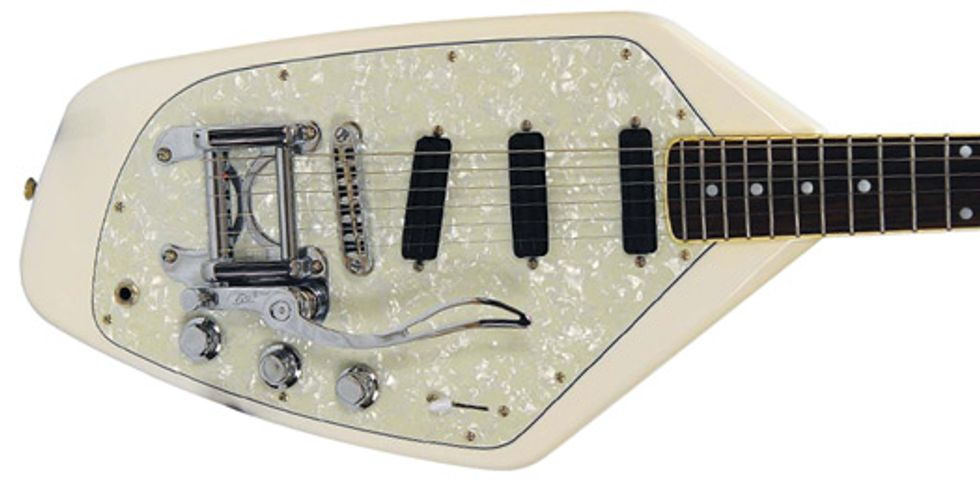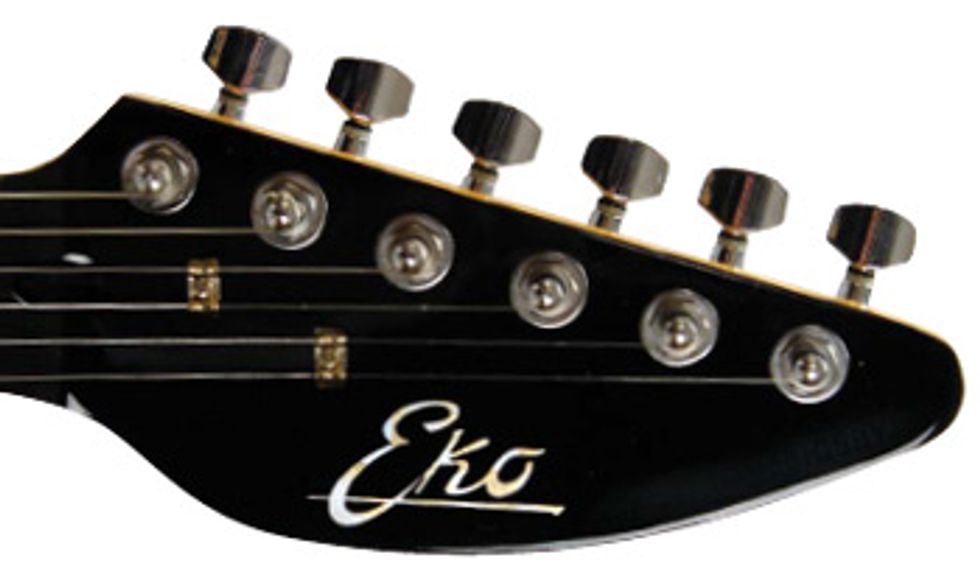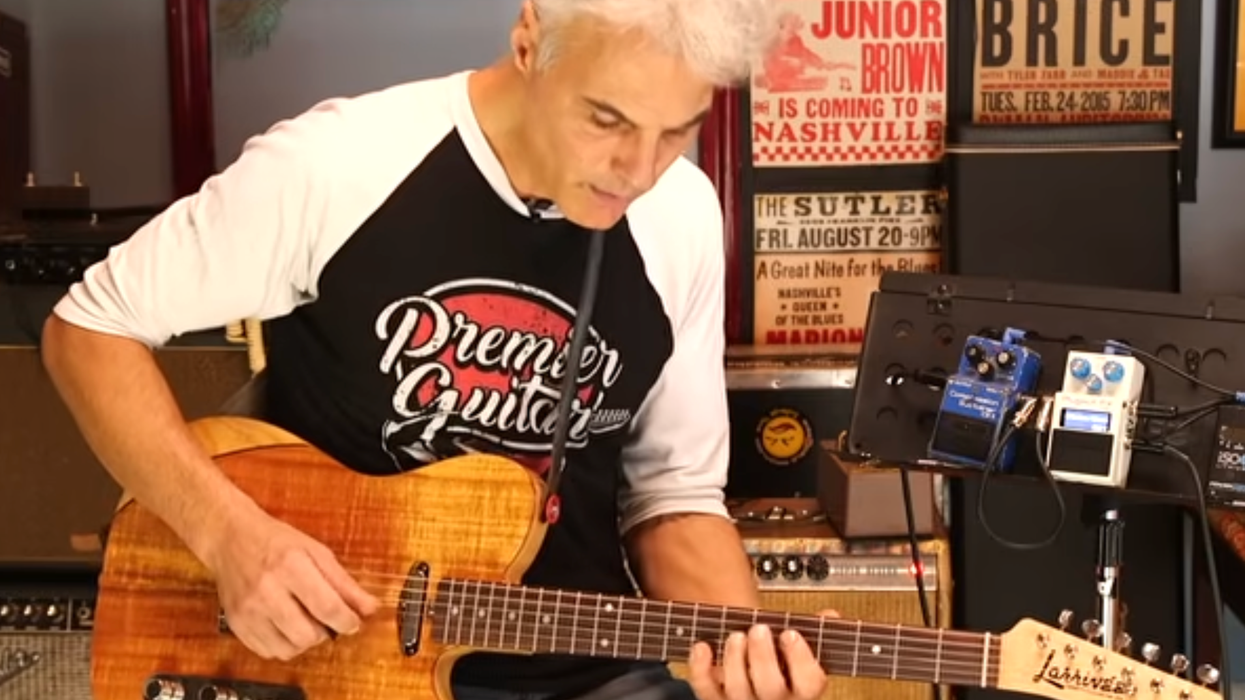| Download Example 1 Bridge Pickup | |
| Download Example 2 Neck Pickup with Vibrato | |
| Clips recorded through a 1968 Fender Vibro Champ | |
Italy’s Eko Guitars, always had a close relationship with Vox. In the 60s, the Eko factory produced many of Vox’s most iconic guitars—the Phantom and Mark VI Teardrop included—under license. And, while certain guitar purists regard them as B-grade vintage instruments, they remain some of the most unique-sounding electric instruments on the planet.
The Eko Ghost VI is a stab at reinterpreting the Phantom for the modern player. With its single-coil-sized blade humbuckers and 5-way, Strat-style pickup switch, the Ghost VI will never be mistaken sonically or visually for a vintage Vox—or Eko, for that matter. But it’s an interesting evolution of what was always a fascinating instrument.

Modern Deviations
The Ghost makes no apologies for its design inspiration. But it also deviates from the Vox Phantom in several fundamental respects. First, the basswood body’s profile—though clearly derived from Vox’s original, is cut with a shallower arc along the bass side of the body. It’s a subtle difference, but it does alter the classic proportions of the original Phantom. The headstock is also slightly smaller, though it retains much of the original’s oval shape. And the substantial pickguard, which is in pearloid rather than plain white plastic, comes off as a little glitzy.
The three-in-a-row knob configuration is carried over from the original Vox, but the Bigsby-inspired Hank Marvin Tremolo on the original is replaced by Eko’s own very cool-looking and very ’60s-Italian-styled adjustable-tension vibrato unit.
Some of the Ghost VI’s changes work quite nicely. It has a very comfortable, fast-playing, satin-finished neck with a slim C profile and vintage-sized fretwire that‘s reminiscent of a ’60s Fender neck. It’s an ideal fit for the guitar’s 25.5" scale.
 Contemporary Color
Contemporary ColorAny doubts about where the Ghost VI resides on the line between modern and vintage, from a sound perspective, will be answered the second you plug in and turn up, which I did through a Fender Bassman 4x10 reissue and a silverface Fender Twin. The bridge humbucker has a distinct humbucker-equipped-Telecaster snap that would cut through any band mix, and it worked very nicely with the high-headroom Twin and the darker, meatier Bassman for a little chicken-pickin’ paradise. Selecting the bridge and middle pickups transformed the tone into a classic Richard Thompson/ Knopfler-esque, out-of-phase Strat tone that inspired me to play along with a few favorite Fairport Convention jams. It’s a great illustration of how these pickups manage to impart a lot of single-coil character with much greater headroom.
With an admitted predisposition about how a Vox-style guitar should sound, I was initially a little confused by the disparity between the look of the guitar hanging around my shoulder and the Fender-y tones that spilled forth. And the light setup (the guitar was strung with .009s and low action) confounded my initial attempts to dig in and play the fast, heavy folk-rock arpeggios I’d be inclined to play on a vintage Phantom. But once I was better acquainted with the tonal characteristics of the pickups and the Ghost’s slinky feel, I was more than happy to string together some legato runs, full-step bends, and fast finger vibrato. And that re-orientation of my approach to the guitar reinforced my thoughts about how comfortable and playable its neck is.
Neck and neck-and-middle pickup configurations delivered more of the familiar Strat-with-headroom quality you tend to get out of blade-style humbuckers. But they seemed to work best in out-of-phase positions, where working the tone knob summoned all kinds of cool, boxy tones that still sustained and sang beautifully.
In general, the tremolo system was ill-matched to the Ghost as it was set up. The attractive, Bigsby-inspired unit worked with a mellow touch when I reduced the tension on the arm, but that adjustment seemed to also make the guitar more susceptible to slipping out of tune. If you choose to forego the tremolo entirely, it can be tucked away just like a Bigsby by turning the arm around backwards, which also has the benefit of improving access to the aft-most tone control.
The Verdict
There is definitely a disconnect between how the Eko Ghost VI plays and sounds and how most experienced Vox fans will expect it to play. But for players unfamiliar with the vintage Vox and Eko legacy of snorkely pickup tones and jangle-ready setups, the Ghost VI is an appealing way to get Fender-style playability and tones while getting a whole different visual vibe. Fans of out-of-phase Knopfler sounds will find a lot to like about the clarity and headroom from the humbuckers in bridge-and-middle and neck-and-middle settings. And honky-tonkin’ Telecaster fans will love the civilized-but-nasty treble bite of the bridge pickup through a loud Fender amp. Will those factors sway a buyer otherwise bound for a Strat? From psychedelic revivalists and garage punks to art rockers Phantom-style guitars have always attracted some very left-of-center characters. But it’s fascinating to imagine how players with those sensibilities might appreciate this very playable take on a ’60s-style icon.
Buy if...
you love the out-of-left-field ’60s look but need modern playability and tones.
Skip if...
you think Phantom-style guitars are only good for paddling a canoe.
Rating...
Street $700 - Eko Guitars - ekousaguitars.com |








![Rig Rundown: Russian Circles’ Mike Sullivan [2025]](https://www.premierguitar.com/media-library/youtube.jpg?id=62303631&width=1245&height=700&quality=70&coordinates=0%2C0%2C0%2C0)


























